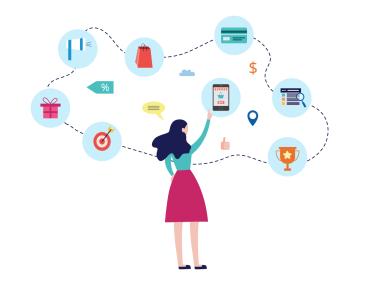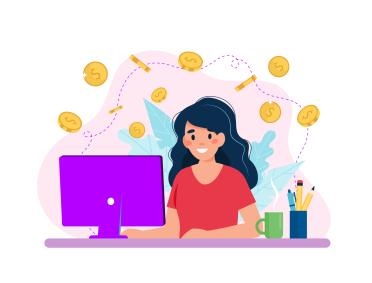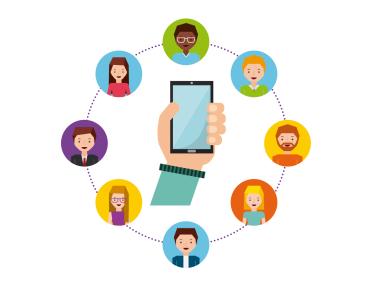What is the buyer's journey?
Businesses are always looking for ways to increase ROI and the buyer journey is a fundamental part of this process. Shopping patterns and behaviours are continually evolving, it’s important to recognise what those changes are and to evolve your own approaches too.
Technology has shaped journeys more than anything, and the majority of buyer journeys now occur online. Whether you’re in the B2C or B2B market, your customers can research and complete much of their journey without even talking to your sales team. This could be a real problem for businesses using the older, more traditional route to sale.
What does today’s buyer’s journey look like?
We need to cater for today’s modern buyer journey. Whilst we are not in control of the direction of travel anymore, we are in control of the content that’s so eagerly consumed along the way. Potential customers arrive at decisions by interacting with content at various stages of their purchase journey. By making it easy to find and consume the right content that meets the specific needs of a specific user, you can make significant gains in lead capture and conversion.

What are the stages of the buyer’s journey?
If you’re from a marketing background, you have likely heard of sales funnels. Sales funnels draw upon principals set decades ago and are still widely used today.
Typically a simple sales funnel comprises three basic steps. These are;
Awareness Stage
Consumers understand they have a need and have made a decision to do something about it. At this stage they are in research mode, trying to shape what their problem and pain points may be. During this stage it’s useful to understand how potential customers may be trying to educate themselves, this can often lead to opportunities to engage in a helpful manner.
They’re now aware that they have something to address.
Consideration Stage
Consumers start assessing and reviewing options. At this stage a buyer has defined their goals and understands what they need to address. They are much more committed to a solution or product that addresses their needs and have moved onto evaluating the different options and alternatives available to them.
They now have an understanding of the solution
Decision Stage
Having researched and assessed the various options, the buyer now evaluates the pros and cons of each provider. You’ll be in a stronger position if you have provided value and insight during the previous two stages, and your offering is competitive and meets the buyer’s needs.
They decide on the best option and purchase it.
Over time, stages have been added as marketers tried to refine the model, but even with additional stages of “interest” and post sale steps such as “re-purchasing”, the linear model has been pretty much untouched. It still goes from A to B on a well trodden path.
However, whilst they have their use for some cases, linear sales funnels are not nearly comprehensive enough for today’s digital consumers. You may still want your consumers to travel from A to B, seeing your beautifully laid out journey, but the reality is likely to include deviations, retracing steps, comparisons, and iterative research that means you’ll need to consider your content and user journeys from many angles.
Digital journeys are the driving factor behind this, so rather than shop floor layouts, and POS marketing, you now need to be placing efforts firmly in the realms of website optimisation, UX design, personalised content, and customer journey mapping.
From linear selling, to on demand information
How can we conceptualise user journeys if sales funnels are dead? Well, the funnel isn’t dead just yet, but it no longer goes in a straight line. We need to accept that customers engage with you at any, and potentially at multiple times during a purchase journey. The “Consideration” stage still exists for example, but it may consist of sharing content for opinions, comparing prices and benefits, returning later, maybe via remarketing or after further research. Your potential customer may get distracted by an urgent email, and might pick up the journey later on a mobile device.
If you can start to understand what type of experience and information a customer needs, and where journeys and micro journeys may start and deviate, then you can begin mapping some common paths with the content and functionality they need to help and gently nudge them along the way.
A good place to start is user journey mapping.

What are the stages of the buyer’s journey?
If you’re from a marketing background, you have likely heard of sales funnels. Sales funnels draw upon principals set decades ago and are still widely used today.
Typically a simple sales funnel comprises three basic steps. These are;
Awareness Stage
Consumers understand they have a need and have made a decision to do something about it. At this stage they are in research mode, trying to shape what their problem and pain points may be. During this stage it’s useful to understand how potential customers may be trying to educate themselves, this can often lead to opportunities to engage in a helpful manner.
They’re now aware that they have something to address.
Consideration Stage
Consumers start assessing and reviewing options. At this stage a buyer has defined their goals and understands what they need to address. They are much more committed to a solution or product that addresses their needs and have moved onto evaluating the different options and alternatives available to them.
They now have an understanding of the solution
Decision Stage
Having researched and assessed the various options, the buyer now evaluates the pros and cons of each provider. You’ll be in a stronger position if you have provided value and insight during the previous two stages, and your offering is competitive and meets the buyer’s needs.
They decide on the best option and purchase it.
Over time, stages have been added as marketers tried to refine the model, but even with additional stages of “interest” and post sale steps such as “re-purchasing”, the linear model has been pretty much untouched. It still goes from A to B on a well trodden path.
However, whilst they have their use for some cases, linear sales funnels are not nearly comprehensive enough for today’s digital consumers. You may still want your consumers to travel from A to B, seeing your beautifully laid out journey, but the reality is likely to include deviations, retracing steps, comparisons, and iterative research that means you’ll need to consider your content and user journeys from many angles.
Digital journeys are the driving factor behind this, so rather than shop floor layouts, and POS marketing, you now need to be placing efforts firmly in the realms of website optimisation, UX design, personalised content, and customer journey mapping.
From linear selling, to on demand information
How can we conceptualise user journeys if sales funnels are dead? Well, the funnel isn’t dead just yet, but it no longer goes in a straight line. We need to accept that customers engage with you at any, and potentially at multiple times during a purchase journey. The “Consideration” stage still exists for example, but it may consist of sharing content for opinions, comparing prices and benefits, returning later, maybe via remarketing or after further research. Your potential customer may get distracted by an urgent email, and might pick up the journey later on a mobile device.
If you can start to understand what type of experience and information a customer needs, and where journeys and micro journeys may start and deviate, then you can begin mapping some common paths with the content and functionality they need to help and gently nudge them along the way.
A good place to start is user journey mapping.
Mapping the buyer journey on your website
There are plenty of user journey maps readily available by carrying out a quick search on your favourite search engine. However, one thing that all agree on is that user journey mapping should begin by attempting to understand who your users and target audience are. Building strong user personas can help with this but you should substantiate this with real data and research where possible. When developing personas you will want to consider motivations, concerns, and hesitations throughout the user's journey, not just at the point of purchase. If you need help with this, this is usually where UX design agencies come into their own.
Once you have a better understanding of your personas, you should start looking at the goals that each of those personas have for each stage of your not-so-linear funnel. Try to identify what your customers want to achieve at each step as they move through from awareness, to consideration, and to decision making. Think about the bigger picture, but also about the micro interaction - what makes you memorable or keeps you in the reckoning for later.
Touchpoints in customer journey mapping
Next, identify the touchpoints where you are able and likely to engage with your customers as they seek to fulfil those goals. This is where you can begin to work on more tangible aspects of your website or application. For example, if you’re selling goods, common touchpoints are product descriptions - how might consumers be comparing your product to the competition? What do they need to see there to fulfil their goal of comparing you? Do they need to see that others recommend you? How does your brand stack up at that specific point in time?
Web design and the buyer journey
Once you have a clear idea of who you’re engaging with and where the key touchpoints are, you can start the process of optimizing your website or application to cater for what those users want, when they want it.
Keywords, or search terms, are an invaluable tool to help you uncover the “what”, missing thus far. Keywords give us great clues into the type of content users are looking for and what they’re expecting to find. People searching for “how to” or “what are” are almost certainly in research mode, looking for answers. Your content needs to cater for that and provide those answers. People searching for “reviews” or “prices” are clearly a lot further along the purchasing process. You’ll want to do your keyword research before you start creating content, but equally important is monitoring how your content is being found and is performing over time - don’t just rest on your research and presumptions!
Make it easy for the next step
Now you have relevant content to help serve your audience for the stage of their buyer journey, you need to ensure that you’re making it as easy as possible for them to make the next step if they’ve been convinced to do so. Your information architecture and user experience is critical at this point. Navigation needs to be intuitive and clear, and call to actions should be carefully crafted to encourage that user’s progression on your site. And be wary of what “progression” means at this point, should your CTA go directly to purchase, or is your potential customer still in the research stage, looking for more information or perhaps a free trial?

Test and refine with real data
Finally, you can plan, research, map probable journeys, and hypothesise almost endlessly to arrive at what you believe are the ideal buyer journeys through your website. But as part of your ongoing site optimisation, it's important to test if your assumptions you have made are correct.
Reliable information is essential to this process, so collect data when and where you can. Without that you’re left with hunches and relying on gut feeling.
Designing your website for the buyer journey is an ongoing, iterative process, that is refined and improved upon over time. If you think you’d benefit from a web design overhaul, check out our UX design and web design services, or start a conversation with one of our team for more.

